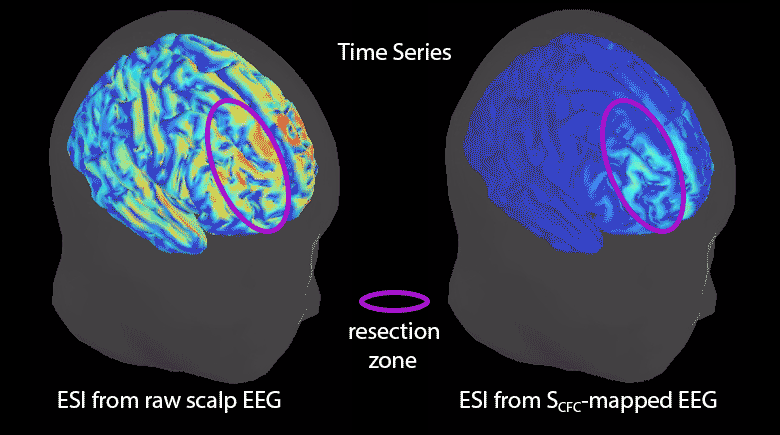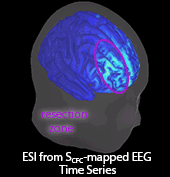
Chunsheng Li, Daniel Jacobs, Trevor Hilton, Martin del Campo, Yotin Chinvarun, Peter L Carlen, and Berj L Bardakjian, University of Toronto, Canada.
The epileptogenic zone (EZ) is a brain region containing the sources of seizure genesis. Removal of the EZ is associated with cessation of seizures after resective surgical procedures, as measured by Engel Class I score. This study describes a novel EEG source imaging (ESI) method to estimate the EZ which uses cross frequency coupled potential signals (SCFC) derived from scalp EEG.
Scalp EEG were recorded from ten patients (20 seizures) suffering from epilepsy. The SCFC were constructed from the phase and amplitude of lower and higher frequency rhythms 10s in duration from electrographic seizure onset. Rhythms were selected by -3dB thresholding a global cross-frequency coupling index. Validation of the technique was facilitated by (i) forward and inverse computer modelling of known cortical sources, and (ii) the correspondence of the ESI with EZ in resected regions of patients.
For ten seizures sampled at or above 500 Hz from four patients, all estimated sources lay within the resected region, emphasizing the clinical importance of higher sampling rates. ESI of the Scfc highlighted areas outside the resection for Engel II-IV patients. The SCFC demonstrated significant advantages over the “raw” scalp EEG. Modelling investigations indicated that a signal-to-noise ratio above 0.2 was sufficient to achieve successful localization in the presence of EMG artifacts.
The association of the estimated sources to the EZ suggests that cross frequency coupling is a feature of the brain’s neural networks, not of artifactual activity. ESI results agree with resected regions of patients with varying Engel Class scores, assuming high-frequency sampling rates greater than or equal to 500 Hz. We propose this approach to enhance the placement of intracranial electrodes for surgical intervention.
Keywords: Epilepsy; EEG source imaging (ESI); cross frequency coupling; modulation index (MI); artifactual immunity.

